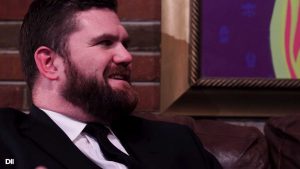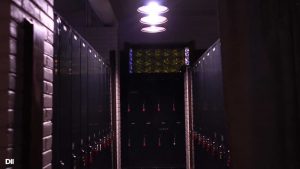Paddy is tall, has a rich voice, and wears suits – giving him the look of a retired football player. Which he is. He studied English and Theology on scholarship at Boston College, before deciding to pursue a second degree in Mortuary Sciences and join the family business, Lynch and Sons Funeral Directors.
Yes, Paddy Lynch is a funeral director. And he comes from a long and distinguished line of them. His uncle, Thomas Lynch, is an essayist and poet, whose writings inspired the HBO series Six Feet Under.
When you’re a funeral director, from a family of funeral directors, this is the first thing people want to write about. But what makes Paddy a compelling character isn’t his line of business, but the mystery of how he got into it. When I approach him with this question, he makes it clear that, despite being the only son, there was no pressure from his father to join the family business.
He came to it on his own. For reasons he doesn’t quite explain.

PADDY LYNCH TALKS TO CV HENRIETTE ABOUT THE SCHVITZ. PHOTO KATAI
ONE GETS THE FEELING PADDY IS CALLED TO THINGS
Paddy was offered the chance to play football in Boston, but turned it down to return home to attend Wayne State University for mortuary school—the same school his grandfather, uncle, and father had attended. It wasn’t an easy decision, and the path ahead proved to be no easier.
In the same conversation he broke the news, he announced to his father that, before returning home, he would be spending the next year working in Haiti.
“I lived with a small group of monks who lived a very austere lifestyle. We’d have to pray in the morning, then at sunset and recite the solumns. During the day I’d work primarily with orphans teaching English and computer literacy. Mother Teresa had one of her hopes for the sick and dying there, which was mostly babies and infants with HIV and AIDS. I was spending a lot of time in this devastation and coming back to this austere monetary, totally isolated, and my mind came undone a little bit. When I came home, I was pretty broken down in some tough ways.”
As difficult as that time was, and as much as I still feel the pain of it, I don’t think I would necessarily be able to do what I do today in funeral service if I hadn’t had that experience. It taught me the limits of my psychology and mental fortitude.”
“SCHVITZ” IS A YIDDISH WORD. IT MEANS TO SWEAT
To sweat is to purge, to release—a ritual as closely related to life as death.
A few years ago, Paddy took a loan out on his Arden Park home to purchase the old building on Oakland Avenue that he openly refers to as “a total money pit.” Purchasing wasn’t a real estate move as much as it was a way to keep around the thing he loved. He’s been a regular for years, coming weekly to sauna and socialize.
Drawn to the Schvitz for its legendary steak dinners and jovial, if not seedy, atmosphere, he credits both the heat and the comradery of its bathers as source of healing through a difficult period, that still nourishes him today.
“What I have come to believe, more and more, is that human beings are wildly different from one another in so many different ways. There are so many nuances to the human soul, and yet, we are so universal, it’s silly. Living between those two extremes is the magic of the Schvitz. It’s incredibly communal—much more communal than most anything else we see today. Generally speaking, as a society, we used to have much stronger neighborhoods, faith communities, unions, fraternal organizations. The things that transcend racial and socio-political identities, but more and more we rely on Facebook groups and other forms of strange ways of pretending we’re in communication when we’re not, and this place forces people to sit at the same table.
The guys who I’ve been coming here with for years Wednesday and Thursday nights—what they’ve taught me is that you do not have to like each other, but you must love each other.”
It wasn’t for sale. He wasn’t even looking to buy it, but it found its way to him.
Why? Because “People need the Schvitz.”
Last month over a thousand people stepped through its doors. “Five years ago,” he estimates, “that number would have been a few hundred.
THE BUILDING STARTED ITS LIFE AS A JEWISH COMMUNITY CENTER
And has since gone through its own ups and downs. Early in its history, a man named “Toots” walked off the street looking for work. He was handed a shovel and asked to dig a pool in the basement. The year of its completion, 1930, is marked with a tile of what is now the cold dipping pool. Rocks were collected. A banya was erected. As was a mikveh, that was later turned into a jacuzzi and then boarded up, to be discovered years later by Paddy and his crew.
Toots remained the building’s guardian for the remainder of his life, something to the count of 50 years. No doubt he saw a lot. The rise and decline of a religious community as well as the Purple Gang and various politicians, who viewed the saunas as a protected space in which to conduct business—”When you’re in here,” Paddy points out, “You can’t wear a weapon, and you can’t wear a wire.”
I first learned of the Schvitz over a decade ago during my time with Isaac Agree Downtown Synagogue, an institution with a similarly storied past: a community held together by a dwindling base of regulars, struggling to keep their buildings from decay or sale.
At the Synagogue this plight was told in colorful stories of Rabbi Antonini and overlap with the topless club across the street. The Schvitz has the infamous couples night.
There was a lot to clean up.

THE SCHVITZ LOCKERS. YES, THEY ARE CO-ED. PHOTO KATAI
HE TALKS ABOUT GHOSTS
A guest recently told him that she could feel many presences in the building—and that they were all happy to be there, that the dead, like the living, chose to return to their place of sanctuary
As far as “health clubs” are concerned, the Schvitz is ok. It’s saunas are luxurious, for sure, but are by no means cutting edge. What the Schvitz offers is a tangible link to the past.
Paddy himself makes the connection often—“The Schvitz is essentially a funeral home without any dead bodies. It’s open to the public. People are coming and going. They’re eating, drinking, emoting. They’re trying to shed some type of burden. It’s cross-cultural. It’s universal. All of us need warmth and healing and regeneration and release, and that’s what people are looking for through funeral rituals and customs.
And ultimately that’s what people are trying to do here. They’re trying to reconnect with their flesh and their mind and their heart.”
As we look to funeral directors for comfort and safe passage of the dead, we come to the Schvitz trusting that we can sweat out our burdens and make it out alive. We put our faith into the hope that good things will come from the heat, in the knowledge of all those who have come before us.
To sit on the bench of the banya is to be surrounded by everyone who has ever sat on its benches—Eastern European immigrants longing for a piece of home, gangsters and crooked politicians searching for sanctuary—as well as the more dubious pleasure seekers.




















